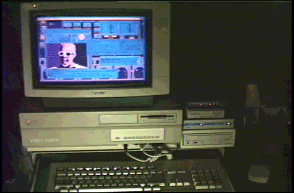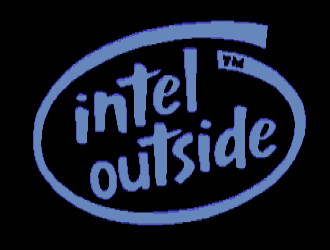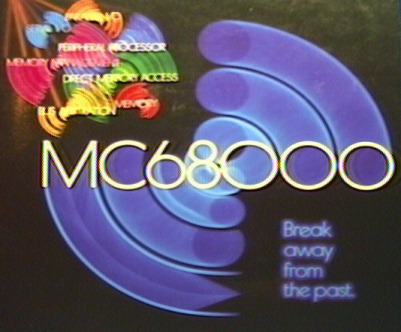

A CPU from the most powerful microprocessor family ever designed was chosen to be the heart of the Amiga: The Motorola MC68000. Introduced around 1979, it features a full 16-bit external and FULL 32-BIT INTERNAL architecture, as well as a 16 megabyte, non-segmented addressing range. Unlike Intel microprocessors of the era, the 68000 does not employ performance-robbing multiplexing of multiple functions onto single pins. The 68000 was introduced literally YEARS before the 8-bit machines with only 64 KB of address space enjoyed most of their popularity!
More recent Motorola CPUs can address over four gigabytes of contiguous, non-segmented memory (as opposed to ALL of the Intel and compatible CPUs, which can only access 64 kilobytes at any given time). Ever see a memory address in a PC referred to by a number such as 0123:1234? The first four digits indicate which 64 KB segment is being referenced, and the second four digits are the address within that segment. No wonder PCs are so slow, what with the need to undergo extra gyrations just to switch between every 64 KB block of memory...
Introduced in 1985, the Amiga computer also contains specially-designed custom sound and video chips, allowing multitasking, animation, and other capabilities nearly unheard of then, and still barely possible on other platforms. In fact, the Amiga invented 'multimedia' long before the term was even coined.
The Amiga's operating system (AmigaDOS and the Workbench GUI, collectively referred to as AmigaOS) is extremely fast and efficient, unlike anything from Microsoft, Apple, and the like. The Amiga's command line interface (CLI) and graphical user interface work together in a way never achieved on any other system. For example, the icons on the screen within the GUI are the actual files which are accessible from the CLI. There is no analogy on the Amiga to the problem of incompatibility between 'DOS' and 'Windows' programs, and no analogy to nebulous, meaningless concepts such as 'program groups'. As far as small size and high efficiency, AmigaOS may be booted quite usably with the full GUI, multitasking, etc. from one double-density (880 KB) 3.5" floppy disk, with no hard drive present at all. It will run in as little as 512 KB of RAM, as well.
With its unparalleled multitasking and multimedia capabilities, the Amiga is right at home on the Internet. It should be noted that the Internet is primarily a network of UNIX computers, and that AmigaDOS is similar to UNIX. Many UNIX programs have been recompiled on the Amiga with relatively little difficulty. To illustrate one of the benefits of Amiga Internet use, imagine 'surfing the web' with absolutely no hard drive grinding! In fact, nothing on the Amiga is dependent upon shoddy, Wintellian implementations of virtual memory.
Unlike virtually all other platforms, the Amiga was designed from the beginning to support modern computing concepts. Every Amiga offers an impressive array of I/O ports as base equipment. This includes the following:
- Analog RGB, digital RGB, and composite video (mono or color, depending on model; also modulated RF on some models) output
- Stereo audio output
- System bus port or expansion slots (depending on model)
- RS-232 serial port (capable of MIDI baud rate)
- True bidirectional parallel port
- External floppy drive port
- Keyboard interface (except models with internal keyboards)
- Dual mouse/joystick ports (with absolutely no conflicts with serial ports, etc.)
As can be seen, any Amiga is ready for numerous tasks without need for additional hardware (video cards, sounds cards, I/O cards, etc...). Of course, such options are available for nearly all models as well, for the ultimate in flexibility and expansion potential.
This page was becoming too cluttered with Wintel-related negativity. A comprehensive list of the hardware and software limitations of the PC platform may now be found on my PeeCee Problems Page. Note that the Amiga possesses none of the deficiencies listed therein. :)
On a similar note, commentary regarding the Apple Macintosh may be found on my Mac page.

Actually, this machine (Millennium) is now equipped a bit differently than it was when I digitized that picture. Its more important specs: GVP accelerator with 40 MHz 68EC030 and 40 MHz 68882, 1 MB chip RAM, 8 MB 32-bit fast RAM, 2 GB Quantum Fireball SCSI HD, Sony 2X internal SCSI CD-ROM drive, internal+external 880 KB floppy drives, GVP IO Extender (additional dual high-speed serial and bidirectional parallel ports), DCTV (24-bit NTSC composite digitizer and display unit), and Magnavox 1CM135 stereo RGB/composite monitor. It runs AmigaOS 3.1, of course. :)
My other primary Amiga (Apocalypse) is an A1200. Its main specs: stock 14 MHz 68EC020, 2 MB chip RAM, 8 MB fast RAM, 1.2 GB Toshiba 2.5" IDE HD, internal+external 880 KB floppy drives, and SupraFAXModem 288 (flash upgraded for 33.6K; the very best modem ever built!). KS 3.0 and WB 3.1. This machine drives a Princeton Ultrasync monitor, typically at 720x454 resolution, displaying a 256-color, flicker-free 27.66 KHz Workbench.
Check out the future of the Amiga at the Official AMIGA Homepage.
The phenomenal A\Box might have been built by Phase 5.
Lots of good Amiga info can be found via CUCUG's Amiga Web Directory.
Make sure you visit Omnipresence International's Amiga Home Page.
Looking for other Amiga-related pages? Find them with AmiCrawler.
It is amazing how many web pages are Made On Amiga.
The world's largest software archive for any platform is Aminet.


 This page is perpetually under construction.
As time permits, additional Amiga info and links should be forthcoming.
This page is perpetually under construction.
As time permits, additional Amiga info and links should be forthcoming.
Last updated: 14 April Y1.999K
